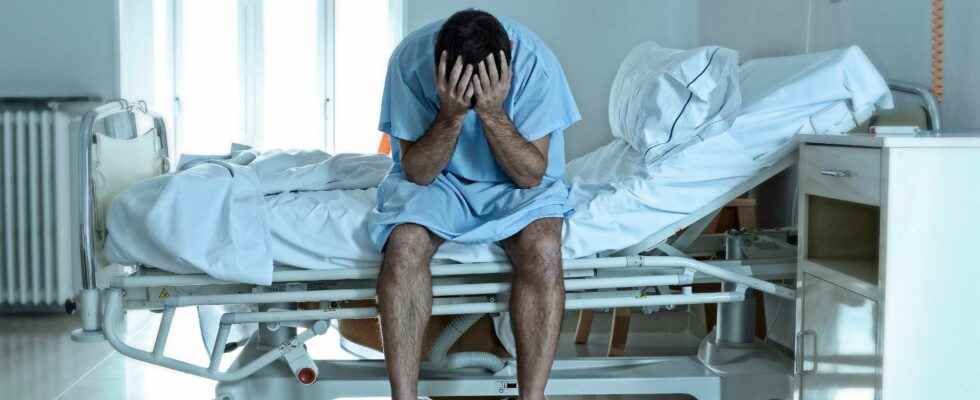You will also be interested
[EN VIDÉO] Monkey pox, should we be worried about it? What are the symptoms, the modes of transmission and how to treat it? Monkey pox or Monkeypox is beginning to worry people.
1er last July, theWHO expressed concern about the spike in cases of smallpox of the monkey in Europe, whose number had tripled in 15 days. A week later, in France, the High Authority of Health advocated expanding the vaccination prevention to the most exposed groups, an opinion followed by the government.
University professor and hospital practitioner at Bichat Hospital (AP-HP), Xavier Lescure takes stock of the situation and comes back to the signs that should alert.
The Conversation: As of July 12, Public Health France counted 912 confirmed cases of monkeypox in France. How is the virus responsible for the disease transmitted? What signs should alert?
Xavier Lescure: the virus Monkeypox, which causes this disease, can be caught by touching the lesions (pimples, pustules) of an infected person or objects that have been contaminated (linen, cutlery, etc.). It is indeed able to survive several days on inert surfaces. It enters the body through microlesions in the skin, which are present all the time but are not necessarily noticed. Scratch it nose with contaminated hands is another way to get infected.
The incubation phase lasts from 6 to 13 days. It is followed by a prodromal phase which lasts about two days during which the warning signs of the disease appear: fatigue, feverheadache, muscle aches, increased volume of the lymph nodes…
During this period, the virus is present in the blood. It is possible that he could transmit by air (via large droplets or aerosol). However, scientific evidence is still lacking to firmly support this hypothesis. We therefore consider that we are generally little – or even not – contagious during this phase, which is not constant in all patients.
On the other hand, we become contagious once the lesions appear, because they contain viruses. Initially, symptoms resemble those of the varicella with a few differences: the lesions are not quite the same and, above all, their location is different. Unlike the varicellathey can here develop on the palms of the hands or the soles of the feet.
The characteristic rash often begins on the face or genitals (depending on the mode of transmission). The lesions are associated with severe pain, which may occur before the lesion erupts, and is often accompanied by lymph nodes.
The Conversation: How does this outbreak differ from those typically seen in areas where the virus is endemic in Central and West Africa?
Xavier Lescure: This is the first time that such a large number of human-to-human contaminations have been documented.. In Africa, transmission between individuals is usually not very important: when the passage is from animals to humans, there are a few secondary cases but the epidemic generally dies out on its own.
This difference is explained by theemergence another mode of contamination in Western countries: transmission through intimate contact, during sexual intercourse. For the moment, these contaminations concern people with multiple partners, the vast majority of men who have sex with men (as of July 6, only four women and two children had been infected, editor’s note).
Another difference: in Western countries, no deaths are to be deplored for the moment and there have been few hospitalizations. One of the reasons is that affected patients, mainly young men, are not at risk of a severe form. In addition, secondary bacterial infections, common in Africa and often responsible for aggravating the condition of patients, are treated without difficulty in France.
Remember that vaccination against smallpox (which also protected against monkeypox) was stopped after disease eradication, more than 40 years ago. This judgment is perhaps no stranger to the re-emergence of Monkeypox in the countries of the South, then at home.
The Conversation: Does this unique mode of transmission translate into other clinical forms of the disease?
Xavier Lescure: Yes. The patients we receive have attacks that differ quite significantly from those described in endemic areas.
In addition to classic dermatological lesions, there are tonsillitis important, inflammations of the mucosa very painful rectum, pharyngitis, impairment eyepieces (inflammation of the cornea), inflammation of the urethra… In certain aspects, these clinical presentations recall the sexually transmitted infections. But wearing the condom is not enough to protect against the disease since skin-to-skin contact is enough to transmit the virus.
Wearing a condom is not enough to protect against the disease since skin-to-skin contact is enough to transmit the virus
Even if monkeypox is a relatively mild disease for which we have treatments and vaccines, it is better to avoid catching it… Indeed, the patients we receive suffer a lot, to the point of sometimes having to resort to morphine. In addition, the lesions can leave scars dysaesthetic, often located on the face, which can be morally difficult to bear.
Finally, illness affects the intimate: it can put light sexual behaviors that are not necessarily always assumed.
The Conversation: The number of lesions can vary from person to person. Do we know why? Can we limit the quantity, or influence their evolution?
Xavier Lescure: We currently have little scientific data concerning the reasons for the variability in the number of lesions (which is an indicator of the importance of the attack: beyond 100 lesions, we are faced with a serious dermatological form). It most likely depends on the genetics of the host. The amount of virus at the time of contamination may also play a role, as does the mode of contamination.
Nothing can be done to limit the number of lesions, but the risk of bacterial superinfection can be limited. This requires avoiding excessive scratching, even if the lesions itch. Disinfecting them and covering them with a bandage can help, not to mention that it can also limit transmission.
Some treatments are potentially able to shorten the duration of the progression of the disease. This is’antivirals : Tecovirimat, brincidofovir and cidofovir (in order of preference according to the recommendations of the High Council for Public Health). But these drugs are difficult to access. They are indicated in severe forms or for people at risk of severe forms, and can, at least in theory, accelerate the healing.
The Conversation: Could monkeypox be circulating more widely in the coming months?
Xavier Lescure: Predicting the evolution of the epidemic is at this stage very difficult because the mathematical models are still being developed.
The task is all the more complicated as the current mode of transmission is unprecedented, and the chains of transmission that are being put in place are difficult to establish. It is complicated, if not impossible, to trace the contacts of people who have multiple sexual partners in the context of a festive event.
In addition, even if the patients are not very contagious, they remain so for a long time, which explains the 21-day isolation recommended in the event of infection (incidentally, adherence to a three-week isolation being difficult to obtain , the recommendations have evolved towards a reduction, in order to increase adherence to the constraints concerning the most risky situations).
The more time passes, the more the risk that the contaminations extend beyond the community initially concerned increases. A fear is that the virus will end up reaching people at risk of developing severe forms. This is the case for immunocompromised people, children and pregnant women: the Monkeypox is able to pass the placenta, which can lead to miscarriages; moreover, newborns can also be contaminated at the time ofchildbirth.
Another potential risk is the establishment of what is called a retro-zoonosis: the virus becomes established in an animal reservoir living under our latitudes (like the rodentsessentially), which would result in the disease becoming endemic in our regions.
The Conversation: In this context, the High Authority for Health recommended on July 8 to offer vaccination to “people most at risk of exposure”, namely ” men who have sex with men and trans people who have multiple partners, people in a situation of prostitution, professionals working in places of sexual consumption “. What do you think of this approach?
Xavier Lescure: We are fortunate, on the one hand, to have a well-tolerated third-generation vaccineon which we have hindsight with other microorganisms and, on the other hand, to deal with a disease which, for the moment, only concerns a fairly easy to target population.
Deploying vaccination to people who have multiple sexual partners is therefore probably a good way to prevent the epidemic from spreading. The risk-benefit balance, whether on an individual or collective scale, is clearly favourable. This is probably the best solution.
The question now is whether vaccination will be able to be deployed quickly. This is important, because the season summer, conducive to meetings, cultural events of masscould increase cluster transmissions, leading to wider spread of the disease.
A desire to escape for the summer?
To celebrate the holidays as it should be, discover the Mag Futura at the preferential price of €15 instead of €19, i.e. a reduction of 20% !
On the program of this issue: a dive into the heart of 4 scientific themes that will mark 2022, from the Earth to the Moon:
- What mysteries does the Moon still hide from us?
- Will we soon be able to cure everything thanks to genes?
- How to feed the world without destroying it?
- Can artificial intelligence become truly intelligent?
What is Mag Futura?
- Our first paper journal of more than 200 pages to make science accessible to as many people as possible
- 4 major scientific questions for 2022, from the Earth to the Moon
- Home delivery*
*Delivery is made in France (excluding metropolitan France), Switzerland, Belgium.
Interested in what you just read?

